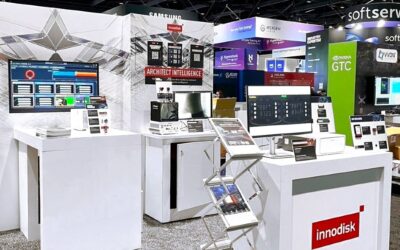A ‘Quick, Perfect, and Golden’ Toolbox for Machine Vision Data Challenges – Written by Jim Witherspoon, Product Manager, Machine Vision, Zebra Technologies
The interest, innovation, and buzz around various types of artificial intelligence (AI) — machine learning, neural networks, and computer vision (CV) is well recognised. What is less recognised is the renewed interest and application of modern machine vision (MV) systems by warehousing operators and manufacturers.
MV and CV are both intelligence-based systems used for image capture, processing, and analysis. However, the speed and level at which this intelligence is gathered, distributed, and applied is one of the most distinguishing factors between the two types of technologies.
MV systems tend to be self-contained, meaning the image capture and analysis occur right there on the line — data does not have to be sent to a back-office system for processing.
On the other hand, CV is often used as a back-end processing platform for front-line image capture technologies. Though CV elicits fast decision-making and action, the lead time tends to be longer, given the depth and breadth of data being processed through the system.
Every company looking to implement MV systems today must decide how to share and manage image datasets and how to use them to deliver quality, actionable results on a consistent basis — data has become as important as code. However, while there are industrial practices for code management, progress needs to be made for managing image data.
One of the biggest challenges we face today, whether as MV specialists or businesses looking to implement MV systems, is the correct capture and annotation of data. However, there are now new solutions to help industrial imaging professionals to think and act like data scientists.
New Machine Vision Systems
Zebra Technologies launched its new line of MV cameras and fixed industrial scanners (FIS) in mid-2021. Zebra’s complementary software, Zebra Aurora™, pairs with Zebra’s MV/FIS portfolio to facilitate the set up and configuration of track-and-trace and quality inspection solutions.
Zebra Aurora was engineered from the ground up to be easy to set up, easy to deploy, and easy to run. This credo was developed from years of market research and working with many of the top users and integrators of FIS/MV. It has really been the engine behind many of the unique differentiators that Zebra Aurora brings to market.
Zebra wants the software to be modern looking while also reducing the number of clicks and mouse movements required for users to deploy a solution. Within the first few minutes of navigating the software, users get to experience new and intuitive ways to work with the images they have captured. Scroll bars have been eliminated, and the interface provides users with an immersive experience more akin to photo editor than traditional MV software offerings.
Perfect, Quick, and Golden
In addition to designing the software with a sleek, modern interface and toolset, Zebra also endeavoured to make the navigation process intuitive for MV inspection and barcode scanning experts, as well as for novice users. To do this, the Zebra MV team broke down the process of creating and configuring the software as follows:
Stage one is ‘Capture,’ for users to setup the exposure, lighting, and triggering. The second stage is ‘Build,’ to make is easier to add and configure MV/FIS tools. And third, ‘Connect,’ makes it painless to get image data from the MV/FIS camera to the host system.
For example, with ‘Capture,’ a user can create 16 individual images to ensure that every inspection or barcode read has the perfect lighting. Zebra calls the feature ImagePerfect+. Often, parts are not evenly lit or have inspections at different depths and focus, necessitating changes to exposure settings.
With ImagePerfect+, a user can quickly adjust the image settings, link the tool they need for the inspection to the ImagePerfect+ bank they created, and get a pass/fail response with a single trigger pull. By eliminating the need for multiple job changes or tracking, ImagePerfect+ can save hours when deploying a system.
When it comes to ‘Build,’ we have QuickDraw, which gives users the ability to draw vision tools directly on the image. This feature alone can eliminate five clicks and drags when adding a tool to a solution. That may not sound like much, but as solutions get more sophisticated, the time savings can really add up.
Another unique tool is called Golden Image Compare — developed to keep the system up and running while eliminating downtime should something happen to the camera or setup. This feature allows a user to capture an image at the time of setup — the time when the system works best — and saves it in perpetuity.
If an issue causes the system to malfunction, the user can simply click on Golden Image Compare and get a side-by-side view of the Golden Image vs. the new image. If the camera was bumped, or a light is no longer working, or if key settings were changed, Golden Image Compare helps users quickly identify the problem and get the system back up and running immediately.
A Powerful Toolbox
While simplifying the ability to configure the software and setup a job is important, the real power of Zebra Aurora is in its performance. It features robust barcode reading and MV solutions today, and plans are underway to make it even more powerful.
Zebra’s acquisition of Adaptive Vision (now Aurora Vision) and Matrox Imaging positions Zebra as a single streamlined provider for most industrial automation applications. Zebra’s intent is to leverage the best-of-breed algorithms and solutions available from Aurora Vision and Matrox Imaging and integrate them into the Zebra Aurora platform.
For example, the latest Zebra Aurora release includes a deep learning-based OCR tool first created by the Aurora Vision team for Zebra Aurora Vision Studio. It is so easy to use, you simply draw a box around your text, and it reads it without having to train any fonts. Zebra also integrated a new barcode reading tool that gives users an additional algorithm to read their challenging 2D codes.
Zebra speaks about its vast software library as a toolbox: no one relies on just one screwdriver to complete a complex construction job, so why rely on just one vision tool? Moving forward, with the addition of the Matrox family of products to the portfolio, Zebra will continue to integrate its development efforts with new best-in-breed tools that the Matrox Imaging family provides. The goal is to give users the best and most appropriate solutions to address their business application needs.
To learn more about Zebra Aurora, visit zebra.com or download the free software.
Also, stay up to date with the most recent machine vision and image processing news right here on MVPro Media.





